Enterprise Architecture is the combination of Business and Technical Architecture to create a full picture of the Enterprise and a roadmap to meet their goals. However, most companies/organizations do not have an Salesforce Enterprise Architecture available to help on this journey. This gap is especially prevalent in mid-size to small organizations.
What is Enterprise Architecture?
Enterprise Architecture is analogous to “Urban Planning”. Enterprise architecture (EA) is the practice of analyzing, designing, planning and implementing enterprise analysis to successfully execute on business strategies.
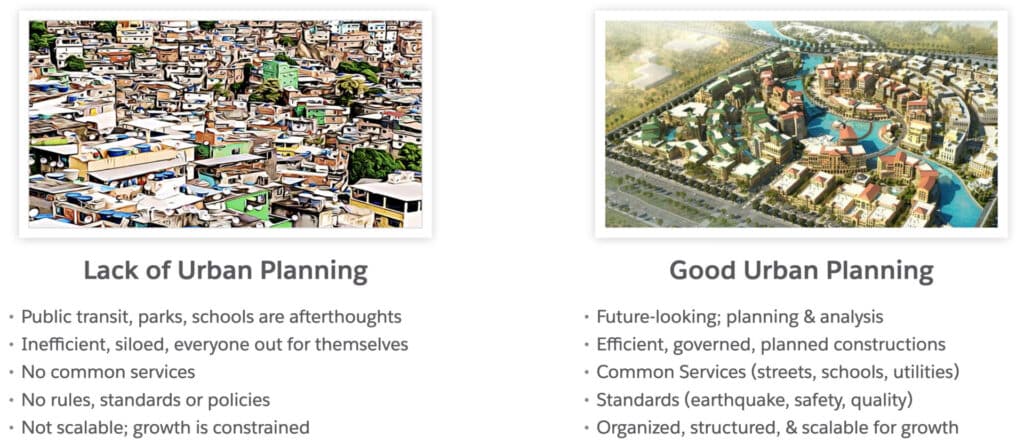
Why is an Enterprise Approach Needed?
- Business transformation should be focused on “EXPERIENCE”
- Data is leveraged across many business functions.
- Business architectures are heterogeneous. Integration is critical.
Enterprise Architecture Methodology
Business Value Led, Light Weight, Minimum Viable Architecture. This is a seven step methodology that we used and evolved over many years at many companies.
- Business Strategy
- Customer Lifecycle
- Capability Map & Gap
- Current State
- Future State Vision
- Strategic Roadmap
- Business Value Assessment
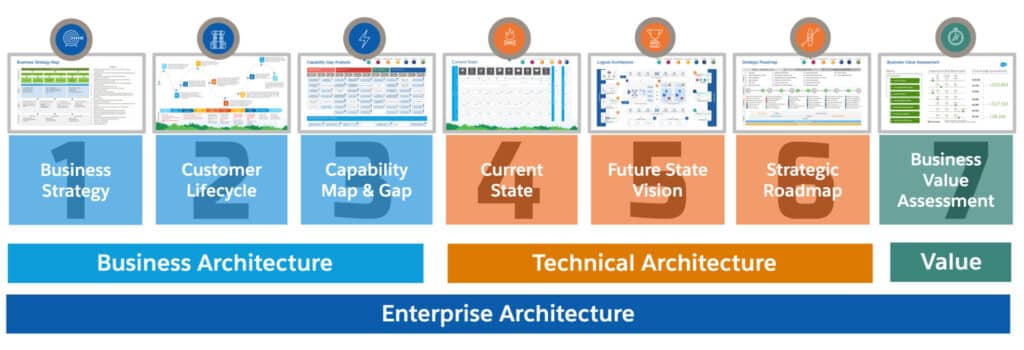
1 . Business Strategy Interviews
The first three steps are focused on the business in terms of goals/objectives and then business capabilities. What are your key goals aligned to your business strategy? What objectives and initiatives do you have to achieve those goals? How will you measure success? What risks and obstacles concern you most?
If you could do one thing that could drive a significant impact, what would it be?
2 . Customer Lifecycle Analysis Workshop
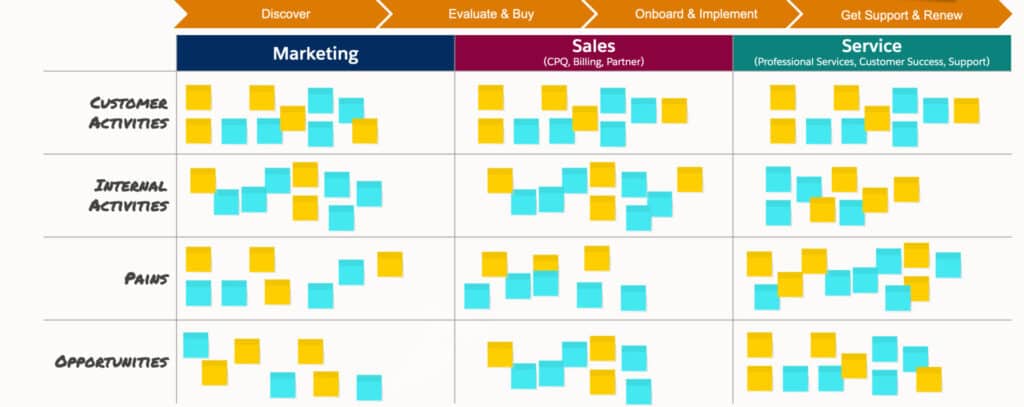
3. Capability Map & Gap
- Methodology to understand where improvements can be most impactful – independent of technology
- Capabilities define what a business does, not how a business does something.
- Capabilities are defined in business terms, not technical terms.
- Capabilities map to, but are not the same as, a line of business, business unit, business process, or value stream.
- Capabilities have relationships to IT deployments and future state IT architecture.
- Automated capabilities are still business capabilities not IT capabilities.Capabilities are of most value when incorporated into a larger view of an enterprise ecosystem
Scoring Rubric Capability
Capability Score
| People | Do you have the people you need for this capability to be successful? |
| Process | Is the process well-defined and appropriate for this capability? |
| Data | Do we have all the data available to perform this capability? |
| Technology | Do we have sufficient technical tools necessary for this capability? |
Business Impact
| High | This capability has a HIGH impact on the overall business. |
| Medium | This capability has a MEDIUM impact on the overall business. |
| Low | This capability has a LOW impact on the overall business. |
Enterprise Architecture – Business Capability Cards
Go to http://sfdc.co/sfccto run Prezi infinite zoom canvas.
Business Capabilities Model
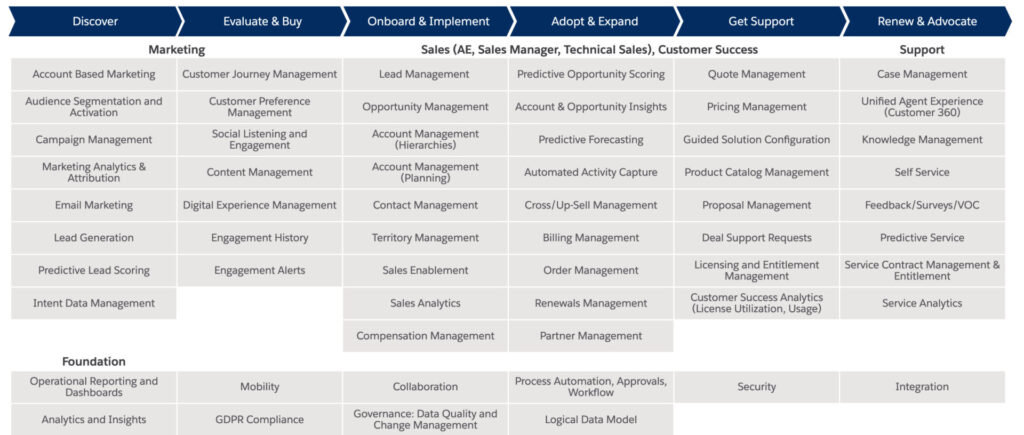
4. Current State Logical Architecture
Current State is tricky — don’t get stuck in an infinite discussion loop about the problems of the current state. Apply a good-enough approach to documenting current state.
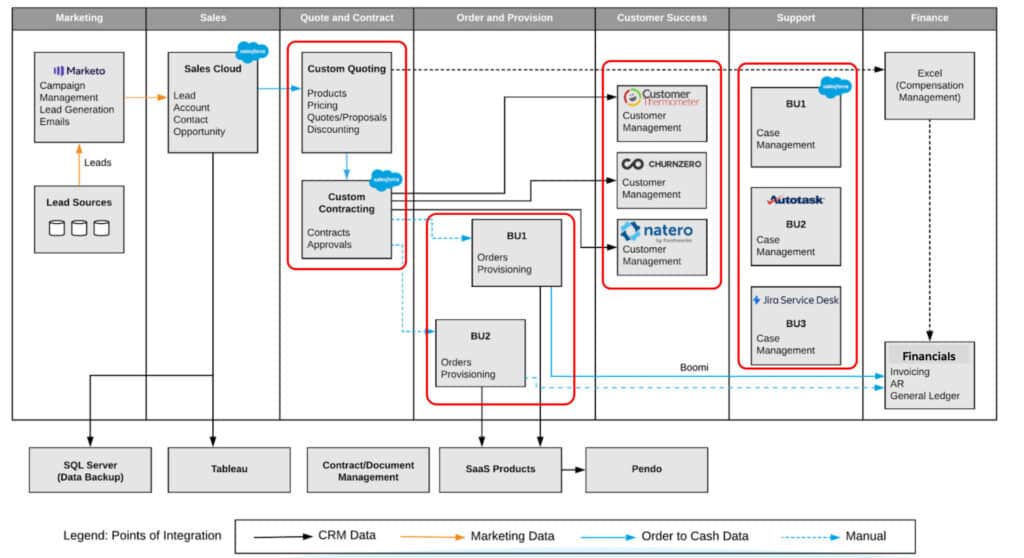
5. Future State Logical Architecture
Future State should be fun! It’s what we call the “north star”. It’s ok if there are transition states between your current state and the future state — realistically it’s not one single step to the future state.
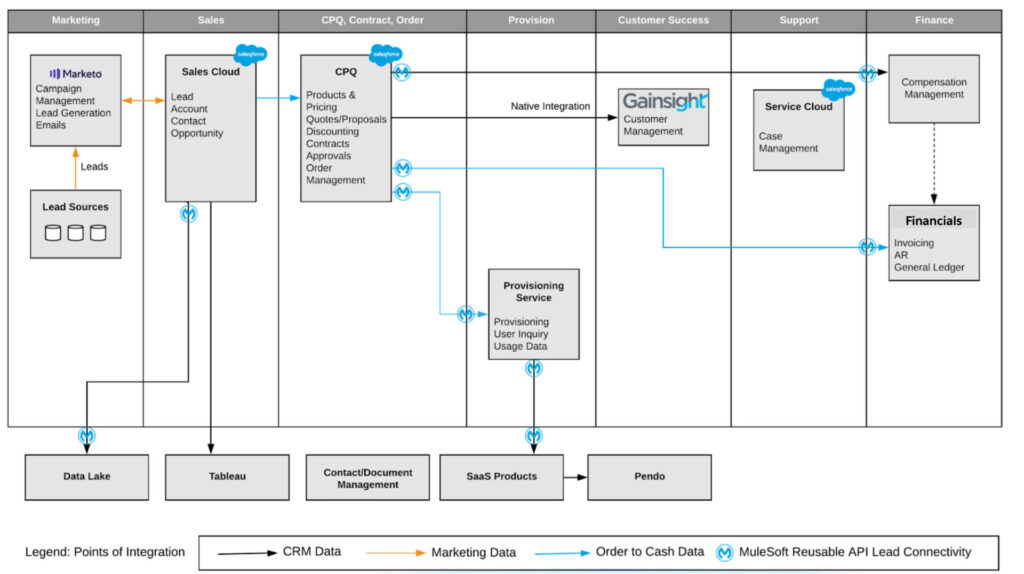
Future State Conceptual Architecture (Long Term View)
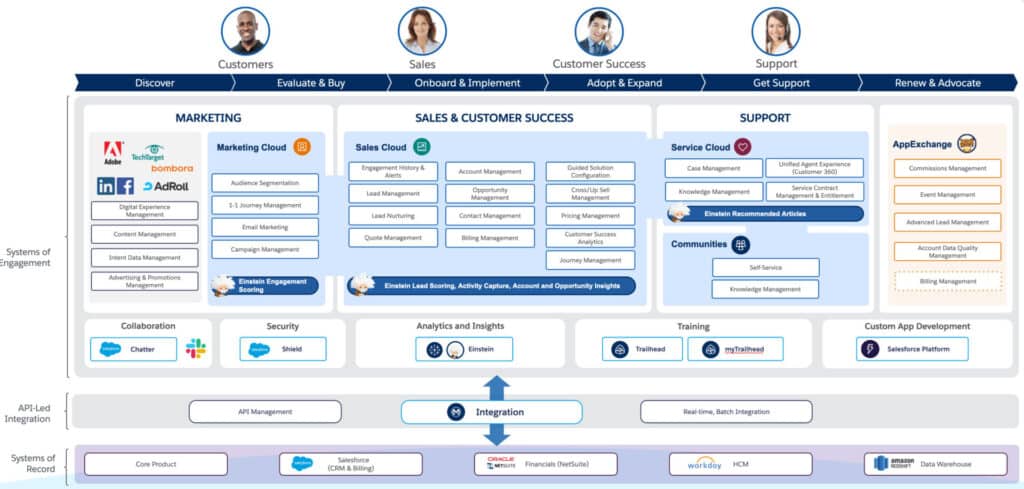
6. Strategic Roadmap
Roadmap is what we consider the toughest step because it’s all about chunking up the evolution to the future state, optimally into quarterly deliverables. The best Enterprise Architects are great at articulating a pragmatic roadmap and it should be appreciated how critical this is
| Phase I: Foundation | Phase II: Optimize | Phase III: Transform | |
| Strategies | Data Architecture & Integration for Account-Based Engagement & Customer Health, Support Optimization | Predictive Intelligence & Insights, B2B Marketing Technology Optimization and Rationalization | Customer Success Optimization, Marketing Transformation, Partner Management |
| Key Capabilities | Enterprise Data Architecture & Integration Account Data Quality Management, Logical Data Model, Integration, New Salesforce Org P2B & CPQ Guided Solution Configuration, Pricing Management, Quoting Management, Billing Management Customer Health Customer Success Dashboard (License & Utilization) Account-Based Sales Optimization Account Management, Contact Management, Territory Management Support Optimization Case Management, Unified Agent Experience, Service Contract Management & Entitlement, Self Service, Knowledge Management | Predictive Sales IntelligenceAutomated Activity Capture Predictive Opportunity Scoring Account and Opportunity Insights Marketing Fundamentals Optimization Lead Management, Lead Nurturing, Campaign Management, Engagement History & Alerts Analytics & Insight Sales & Support Analytics Modernized Support Services Recommended Knowledge Articles, Automated Case Classification Sales Enablement Deal Support Requests | Marketing Transformation Customer Journey Management, Audience Segmentation and Activation (DMP) Customer Success Optimization Customer Journey Management Partner Management Analytics & Insight Marketing Analytics |
| Benefits | 1) Ease of Doing Business 2) Increased Dollar Based Net Expansion Rate 3) Increased Sales Productivity & AE Participation Rates 4) Reduction of Slipped Deals | 1) Increased Sales, Service Productivity 2) Operational Efficiency | 1) Create Delightful Customer Journeys |
7. Value
Business Value although this shows up as the last step in the methodology, it is actually started at the beginning of step 1. In a nutshell it demonstrates QUANTIFIABLY how you will meet the business goals and objectives through the roadmap of deliverables — specifically it shows “at each milestone, here are the quantifiable business metrics we will affect’
Phase 1 Capabilities Can Help ACME Move Towards $1B in Revenue and Bring Quantifiable Value
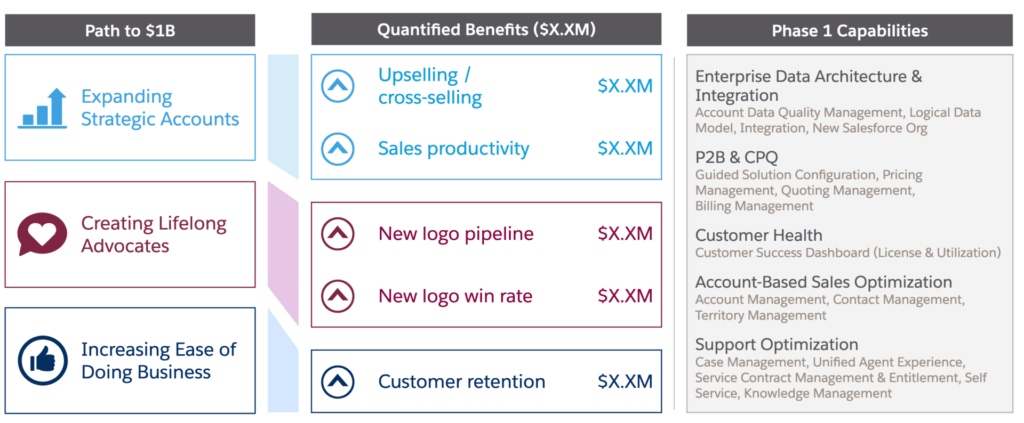
Recording
This session is designed to help advanced Salesforce Developers and Administrators understand a practical approach to Enterprise Architecture for their organizations. Agenda
- Introduction
- Why is an Enterprise Architecture approach needed?
- What is the Salesforce Enterprise Architecture (SEA) Methodology?
- How SEA looks in practice and how you can apply at your organization including Customer Lifecycle Mapping and Capabilities
- Questions and Next Steps
Check out the our YouTube CTA Playlist, and don’t forget to subscribe to our channel, so that you’re notified right away when a new video is available.

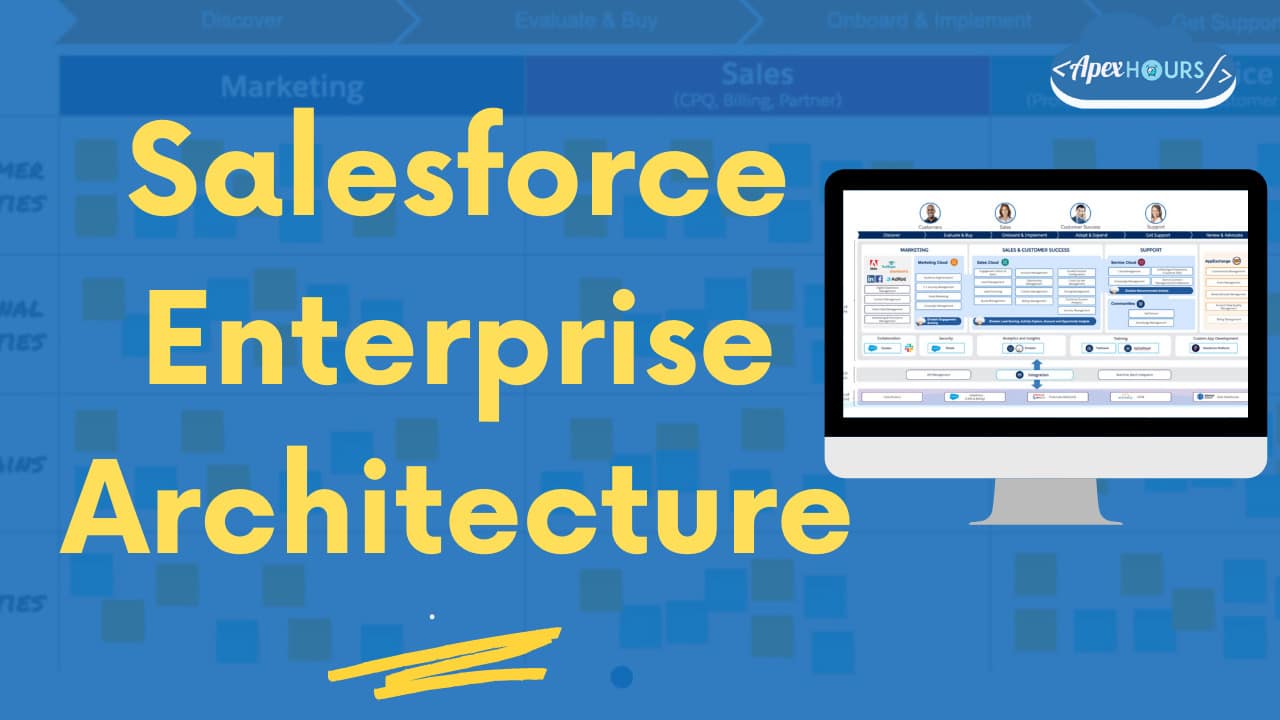

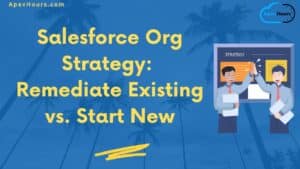
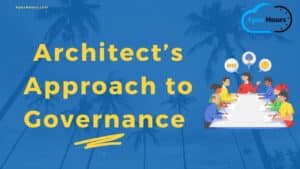
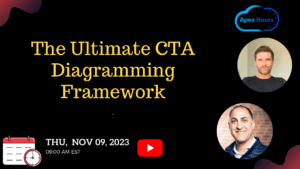
Hi Team,
This is a great session. Thanks for spreading the knowledge.
I am currently on page- https://www.apexhours.com/salesforce-enterprise-architecture/
and looking for presentation that was used in the session. can you please email me with the presentation for this session. thanks.
Have you received the PowerPoint (PPT) for this? If so, could you please share it with me?